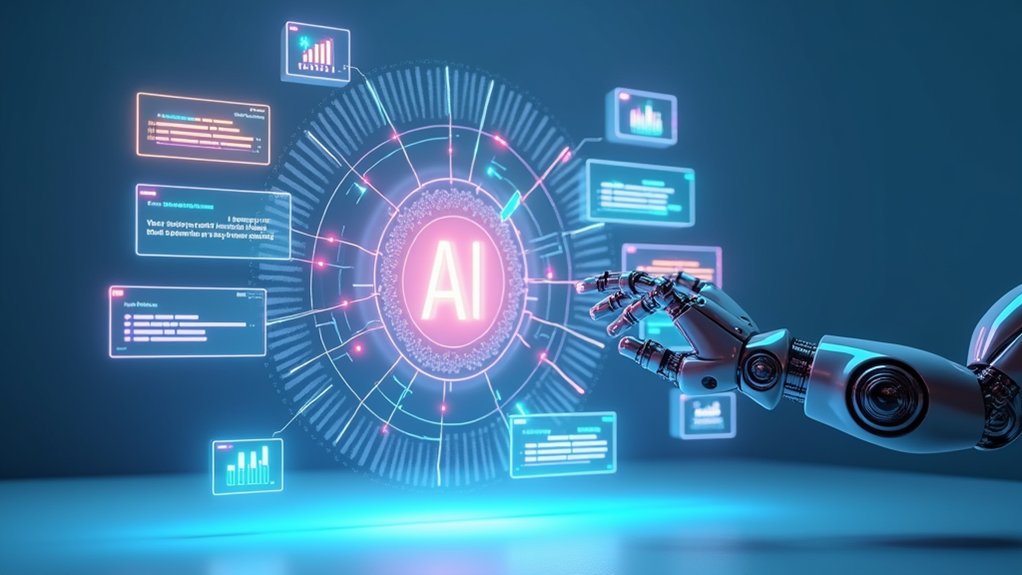Artificial Intelligence Chat: What’s Possible?
Modern AI chat systems now integrate multiple modalities—text, vision, and speech—offering sophisticated interactions across platforms. These systems can interpret images, generate visual content, support complex coding tasks in various programming languages, access real-time data through live browsing, and communicate across numerous languages with cultural adaptations. Business applications include customer service automation, professional communication drafting, and workflow optimization. The competitive landscape features advanced models like GPT-4o, Claude, and Microsoft Copilot, each with distinctive capabilities.

The landscape of artificial intelligence has undergone a profound transformation with the emergence of advanced chat systems that combine multiple modalities and capabilities. These sophisticated platforms now merge text, vision, and speech functionalities to create thorough interactive experiences. Modern AI chat systems can interpret images in real-time, analyze complex visual data, and even generate original visual content based on user specifications. The incorporation of these services across popular platforms like WhatsApp, Instagram, and Facebook has considerably expanded accessibility for users worldwide.
Programming support represents another critical advancement in AI chat functionality. GPT-4o-powered solutions now assist developers with complex coding tasks through real-time generation and debugging capabilities. These systems demonstrate proficiency across multiple programming languages and frameworks while maintaining context awareness when handling extensive codebases. The ability to pass rigorous test cases further guarantees coding accuracy and reliability in practical applications. ChatGPT’s new automation features enable users to accomplish practical tasks through ChatGPT Operators that can book hotels and order food.
Real-time web incorporation enables AI chat systems to access current information through live browsing capabilities. This feature facilitates dynamic data retrieval, context-aware responses based on recent developments, analysis of breaking news, and fact-checking through web-based validation processes. Google’s Gemini chatbot particularly excels by providing real-time data access that integrates seamlessly with Google Workspace tools. The combination of current data with advanced processing creates a considerably more informed interaction experience.
Multilingual support has expanded dramatically, with AI systems now capable of natural conversations across numerous languages with appropriate cultural adaptations. High-accuracy translation services, subtle language understanding, tone recognition, and cross-lingual data processing enable seamless communication regardless of linguistic barriers.
In business environments, AI chat systems demonstrate particular utility through customer service automation, professional communication drafting, data analysis, workflow optimization, and personalized customer interactions. These applications collectively address numerous operational challenges while improving efficiency and consistency. Recent testing revealed that not all AI chatbots are equally effective, with only four out of fourteen passing all coding tests.
The competitive landscape continues to progress as models like GPT-4o compete with alternatives like Claude and Microsoft Copilot. Each platform demonstrates continuous improvements in contextual awareness, interactivity, and response systems, driving the field toward increasingly sophisticated human-like conversation capabilities and practical applications.
Frequently Asked Questions
How Secure Is My Data When Using AI Chat Services?
Data security in AI chat services presents significant challenges. Organizations face considerable vulnerabilities, with 77% experiencing breaches within a year.
While companies increasingly implement protective measures like specialized solutions and governance frameworks, risks persist through shadow AI (concerning 61% of IT leaders) and evolving attack vectors.
Consumer data protection depends on the service provider’s implemented safeguards, transparency protocols, and compliance with privacy regulations—factors that vary substantially across platforms.
Can AI Chats Truly Understand Emotional Context in Conversations?
AI systems can recognize emotional context through techniques like facial expression analysis, speech pattern decoding, and text-based sentiment analysis.
While modern LLMs demonstrate improved capabilities in detecting subtle cues like sarcasm or empathy, significant limitations persist. Cultural differences, linguistic subtleties, and contextual ambiguities continue to challenge AI’s emotional comprehension.
Although multimodal approaches combining visual, auditory, and textual inputs have enhanced emotional recognition accuracy, AI’s understanding remains fundamentally algorithmic rather than experiential.
What Are the Ethical Concerns Surrounding AI Chat Technology?
Ethical concerns surrounding AI chat technology include several critical domains:
- Algorithmic bias perpetuating societal prejudices in automated decisions
- Privacy vulnerabilities through data collection and potential misuse
- Generation of harmful content and misinformation without adequate safeguards
- Lack of true ethical reasoning capacity despite simulating understanding
- Environmental impact from resource-intensive training processes
- Potential workforce displacement in service and creative sectors
- Issues with transparency regarding data usage and decision-making processes
How Do AI Chat Limitations Compare Across Different Platforms?
AI chat limitations vary considerably across platforms, particularly in context window size, natural language understanding capabilities, and task-specific performance.
Free plans typically impose restrictive message limits and reduced functionality. Advanced platforms like NoForm demonstrate superior intent recognition in ambiguous queries, while coding-focused systems like DeepSeek R1 often struggle with consistent programming assistance.
Business-oriented solutions excel in specialized workflows but underperform in multidisciplinary scenarios, creating considerable performance disparities between general and domain-specific applications.
Will AI Chat Eventually Replace Human Customer Service Entirely?
While AI chat will transform customer service, complete replacement of human agents appears unlikely.
Despite handling 95% of interactions by 2025 and resolving routine inquiries with 87% faster resolution times, AI encounters limitations with complex issues, emotional situations, and regulatory compliance.
The evidence suggests a persistent hub-and-spoke model where AI manages standard transactions while human agents address sophisticated problems requiring empathy, judgment, and contextual understanding beyond algorithmic capabilities.